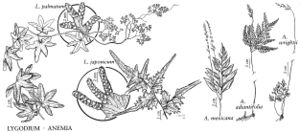familyAnemiaceae
Show Lower Taxa
Difference between revisions of "Anemiaceae"
Treatment appears in FNA Volume 2. Treatment on page 117.
FNA>Volume Importer |
FNA>Volume Importer |
||
| Line 12: | Line 12: | ||
}}<!-- | }}<!-- | ||
| − | --><span class="statement" id="st- | + | --><span class="statement" id="st-undefined" data-properties=""><b>Plants </b>terrestrial or on rock. <b>Stems</b> compact or short-creeping, horizontal, solenostelic (having phloem on both sides of xylem) or dictyostelic (having complex nets of xylem), clothed with orange to reddish brown hairs. <b>Leaves</b> erect [rarely forming a flat rosette], partially to entirely dimorphic. <b>Sporangia</b> in 2 rows on ultimate segments of fertile pinnae, sessile, oblong; annulus apical. <b>Spores</b> tetrahedral-globose, with parallel or rarely anastomosing ridges. <b>Gametophytes</b> terrestrial, green, cordate with unequal lobes.</span><!-- |
-->{{Treatment/Body | -->{{Treatment/Body | ||
| Line 38: | Line 38: | ||
|publication year= | |publication year= | ||
|special status= | |special status= | ||
| − | |source xml=https://jpend@bitbucket.org/aafc-mbb/fna- | + | |source xml=https://jpend@bitbucket.org/aafc-mbb/fna-data-curation.git/src/9216fc802291cd3df363fd52122300479582ede7/coarse_grained_fna_xml/V2/V2_212.xml |
| − | |||
| − | |||
| − | |||
| − | |||
| − | |||
| − | |||
| − | |||
| − | |||
| − | |||
| − | |||
| − | |||
| − | |||
| − | |||
| − | |||
| − | |||
| − | |||
| − | |||
| − | |||
| − | |||
| − | |||
}}<!-- | }}<!-- | ||
-->[[Category:Treatment]] | -->[[Category:Treatment]] | ||
Revision as of 14:14, 27 July 2019
Plants terrestrial or on rock. Stems compact or short-creeping, horizontal, solenostelic (having phloem on both sides of xylem) or dictyostelic (having complex nets of xylem), clothed with orange to reddish brown hairs. Leaves erect [rarely forming a flat rosette], partially to entirely dimorphic. Sporangia in 2 rows on ultimate segments of fertile pinnae, sessile, oblong; annulus apical. Spores tetrahedral-globose, with parallel or rarely anastomosing ridges. Gametophytes terrestrial, green, cordate with unequal lobes.
Distribution
Widespread in tropical and subtropical regions.
Discussion
Genera 2, species 119 (1 genus, 3 species in the flora).
Selected References
None.
Lower Taxa
... more about "Anemiaceae"
